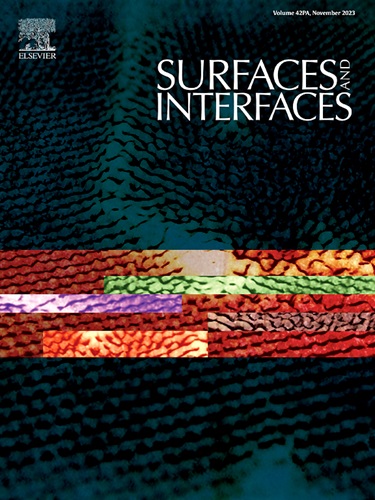提高磷钼共掺杂氮化碳光催化去除有机污染物的性能
IF 5.7
2区 材料科学
Q2 CHEMISTRY, PHYSICAL
引用次数: 0
摘要
元素掺杂是优化氮化碳电子结构和提高其光催化性能的一种广泛采用的策略。然而,单元素掺杂提供有限的增强。本研究采用湿法球磨法制备了磷钼共掺杂氮化碳(P-Mo-C₃N₄)。P和Mo的共掺杂可以协同调节g-C₃N₄的能带结构,显著提高其氧化还原能力,同时它们的相容性有效降低了界面阻力。在罗丹明B (RhB)降解试验中,P-Mo-C₃N₄的一级速率常数(k)为0.1065 min-1,分别比g-C₃N₄、P-C₃N₄和Mo-C₃N₄高10.2、6.5和8.6倍。此外,P-Mo-C₃N₄对盐酸四环素(TC)和亚甲基蓝(MB)具有良好的降解性能。经过5次循环后,催化剂的效率保持在90%,表现出优异的稳定性。这项工作为开发先进的C₃N₄基光催化剂提供了一种经济、环保的方法。本文章由计算机程序翻译,如有差异,请以英文原文为准。
Enhanced photocatalytic performance of phosphorus and molybdenum co-doped carbon nitride for removal of organic pollutants
Elemental doping is a widely adopted strategy for optimizing the electronic structure of carbon nitride and improving its photocatalytic performance. However, single-element doping offers limited enhancement. In this study, phosphorus and molybdenum co-doped carbon nitride (P-Mo-C₃N₄) was synthesized by wet ball-milling, a simple and scalable method. The co-doping of P and Mo synergistically modulates the band structure of g-C₃N₄, significantly enhancing its redox capability, while their compatibility effectively reduces interfacial resistance. In Rhodamine B (RhB) degradation tests, P-Mo-C₃N₄ achieved a first-order rate constant (k) of 0.1065 min–1, surpassing those with g-C₃N₄, P-C₃N₄, and Mo-C₃N₄ by factors of 10.2, 6.5, and 8.6, respectively. Furthermore, P-Mo-C₃N₄ exhibited excellent degradation performances towards tetracycline hydrochloride (TC) and methylene blue (MB). After five cycles, the catalyst retained 90 % efficiency, demonstrating excellent stability. This work provides a cost-effective and eco-friendly approach for developing advanced C₃N₄-based photocatalysts.
求助全文
通过发布文献求助,成功后即可免费获取论文全文。
去求助
来源期刊

Surfaces and Interfaces
Chemistry-General Chemistry
CiteScore
8.50
自引率
6.50%
发文量
753
审稿时长
35 days
期刊介绍:
The aim of the journal is to provide a respectful outlet for ''sound science'' papers in all research areas on surfaces and interfaces. We define sound science papers as papers that describe new and well-executed research, but that do not necessarily provide brand new insights or are merely a description of research results.
Surfaces and Interfaces publishes research papers in all fields of surface science which may not always find the right home on first submission to our Elsevier sister journals (Applied Surface, Surface and Coatings Technology, Thin Solid Films)
 求助内容:
求助内容: 应助结果提醒方式:
应助结果提醒方式:


